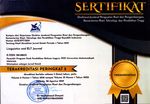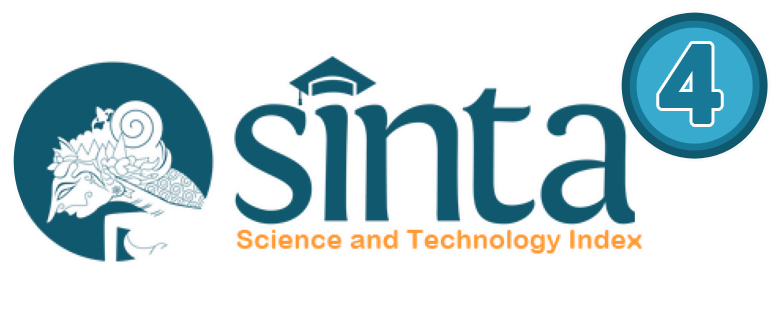The Portrayal of EFL Preservice Teachers’ Engagement in A Video Stimulated Reflection in Teaching Practicum
Abstract
Keywords
Full Text:
PDFReferences
T.S.C. Farrell, Reflective Language Teaching: From Research to Practice. New York, NY: Continuum, 2007.
D. Freeman, Educating Second Language Teachers. Oxford, England: Oxford University Press, 2016.
T.S.C. Farrell, Promoting Teacher Reflection in Second Language Education: A Framework for TESOL Professionals. New York, NY: Routledge, 2015
D. Schön, The Reflective Practitioner: How Professionals Think in Action. Basic Book Inc, 1984.
J. Sydnor, "Using Video to Enhance Reflective Practice: Student Teachers’ Dialogic Examination of Their Own Teaching,“ The New Educator, vol. 12, no.1, pp.67–84, 2016. doi:10.1080/1547688X.2015.1113346.
E. A. Davis, “Characterizing Productive Reflection among Preservice Elementary Teachers: Seeing What Matters,” Teaching and Teacher Education, vol. 22, no. 3, pp. 281-301, 2006, doi:10.1016/j.tate.2005.11.005.
N. Hockly, “Video-Based Observation in Language Teacher Education,” ELT journal, vol.72, no.3, pp. 329-335, 2018, doi: 10.1093/elt/ccy022.
A. Gelfuso, “A Framework for Facilitating Video-Mediated Reflection: Supporting Preservice Teachers As They Create ‘Warranted Assertabilities’ about Literacy Teaching and Learning,” Teaching and Teacher Education, vol. 58, p. 68-79, 2016, doi: 10.1016/j.tate.2016.04.003.
L. Baecher, S.C. Kung, S. Laleman Ward, and K. Kern, “Facilitating Video Analysis for Teacher Development: A Systematic Review of The Research,” Journal of Technology and Teacher Education, vol. 26, no. 2, pp. 185-216, 2018.
S. Walsh, Exploring Classroom Discourse: Language in Action. London: Routledge, 2011.
B. Iasevoli, “Video Links Professors to Far-Flung Student Teachers,” The Education Digest, vol. 82, no. 9, pp. 14–18, 2017.
S.A. Nagro, L. U. deBettencourt , M.S. Rosenberg, D. T. Carran and M.P. Weiss,” The Effects of Guided Video Analysis on Teacher Candidates’ Reflective Ability and Instructional Skills,” Teacher Education and Special Education, vol. 40, no. 1, pp. 7–25, 2017, doi:10.1177/0888406416680469.
J. T. Downer, A. P. Williford, R. J. Bulotsky-Shearer, V. E. Vitiello, J. Bouza, S. Reilly and A. Lhospital, “Using Data-Driven, Video-Based Early Childhood Consultation with Teachers to Reduce Children’s Challenging Behaviors and Improve Engagement in Preschool Classrooms,” School Mental Health, vol. 10, no. 3, pp. 226–242, 2018, doi:10.1007/s12310-017-9237-0.
C. A. Sweigart,T. J. Landrum and R. C. Pennington,” The Effect of Real-Time Visual Performance Feedback on Teacher Feedback: A Preliminary Investigation, ” Education & Treatment of Children, vol. 38, no. 4, pp. 429–450, 2015, doi: 10.1353/etc.2015.0024.
J. A. Fredricks, P. C. Blumenfeld and A. H. Paris, “School Engagement: Potential of The Concept, State of the Evidence,” Review of Educational Research, vol. 74, no. 1, pp. 59-109, 2004, doi: 10.3102/00346543074001059.
E. C. Kahu, S. L. Leach, and N. Zepke, “Linking Academic Emotionsa nd Student Engagement: Mature-Aged Distance Students’ Transition to University,” Journal of Further and Higher Education, vol. 39, no. 4, pp. 481–497, 2015, doi: 10.1080/0309877X.2014.895305.
M. Khademi Ashkzari, S. Piryaei, and L. Kamelifar, “Designing A Causal Model for Fostering Academic Engagement and Verification of Its Effect on Educational Performance,” International Journal of Psychology (IPA), vol. 12, no. 1, pp. 136–161, 2018, doi: 10.24200/ijpb.2018.58146.
W. B. Schaufeli, M. Salanova, V. González-Romá, and A. B. Bakker, “The Measurement of Engagement and Burnout: A Two Sample Confirmatory Factor Analytic Approach, ”Journal of Happiness Studies, vol. 3, no.1, pp.71–92, 2002, doi: 10.1023/A:1015630930326.
R. Pekrun, W. T. Gotz and R. Perry, Positive Emotions in Education.”In Beyond Coping: Meeting Goals, Visions, and Challenges, Edited by E. Frydenberg. Oxford: Oxford University Press, 2002.
R. Pekrun, and L. Linnenbrink-Garcia, Academic Emotions and Student Engagement.” In Handbook of Research on Student Engagement. Boston, MA: Springer, 2012.
J. C. McIntyre, J. Worsley, R. Corcoran, P. Harrison Woods, and R. P. Bentall, “Academic and Non-Academic Predictors of Student Psychological Distress: The Role of Social Identity and Loneliness.” Journal of Mental Health, vol. 27, no. 3, pp. 230–239, 2018.
J. Loughran, Reflection through Collaborative Action Research and Inquiry. “In N. Lyons (Ed.), Handbook of Reflection and Reflective Inquiry: Mapping A Way of Knowing for Professional Reflective Inquiry. US: Springer, 2010.
C. Gaudin and S. Chaliès, “Video Viewing in Teacher Education and Professional Development: A Literature Review. Educational Research Review, vo. 16, no. 16, pp. 41–67, 2015, doi: 10.1016/j.edurev.06.001.
E. R. Kahu, “Framing Student Engagement in Higher Education,” Studies in Higher Education, vol. 38, no. 5, pp. 758–773, 2013, doi: 10.1080/03075079.2011.598505.
S. Lam, B. Wong, H. Yang and L. Yi, Understanding Student Engagement with A Contextual Model. “In S. L. Christenson, A. L. Reschly, and C. Wylie (Eds.), Handbook of Research on Student Engagement. New York: Springer, 2012.
S. K. F. Lee and J. Loughran, “ Facilitating Pre-Service Teachers’ Reflection through A School Based Teaching Programme, “Reflective Practice, vol. 1, no. 1, pp. 69–89, 2000, doi: 10.1080/713693131.
A. M. Mackinnon, “Detecting Reflection-in-Action among Preservice Elementary Science
Teachers, “ Teaching and Teacher Education, vol. 3, no. 2, pp. 135–145, 1987, doi: 10.1016/0742-051X(87) 90014-X.
S. B. Merriam, Qualitative Research: A Guide to Design and Implementation, San Francisco: CA, Jossey-Bass, 2009.
J.L. Bowden, L. Tickle and K. Naumann, “The Four Pillars of Tertiary Student Engagement and Success: A Holistic Measurement Approach, “Studies in Higher Education, vol.46, no.6, pp. 1207-1224, 2021, doi: 10.1080/03075079.2019.1672647.
H. P. Widodo, “Metodological considerations in interview data transcription,” International Journal of Innovation in English Language Teaching and Research, vol 3, no. 1, pp. 101-107.
L. Chipchase, M. Davidson, F. Blackstock, R. Bye, P. Colthier, N. Krupp, W. Dickson, D. Turner, and M. Williams, “Conceptualising and Measuring Student Disengagement in Higher Education: A Synthesis of the Literature.” International Journal of Higher Education, vol. 6, no. 2, pp. 31–42, 2017, doi: 10.5430/ijhe.v6n2p31.
A. M. Klem and J. P. Connell, “Relationships Matter: Linking Teacher Support to Student Engagement and Achievement. ”Journal of School Health, vol. 74, no. 7: 262–273, 2004, doi: 10.1111/j.1746-1561.2004.tb08283.x.
P. Hiver,“Tracing the Signature Dynamics of Language Teacher Immunity: A Retrodictive Qualitative Modeling Study, “The Modern Language Journal, vol. 101, no.4, pp. 669–690, 2017.
Q. Gu and C. Day, “Teachers Resilience: A Necessary Condition for Effectiveness,” Teaching and Teacher Education, vol. 23, no. 8, pp. 1302–1316, 2017, doi: 10.1016/j.tate.2006.06.006.
P.Hiver and Z. Dörnyei, “Language Teacher Immunity: A Double Edged Sword,” Applied Linguistics, vol. 38, no.3, pp.405–423, 2017, doi: 10.1093/applin/amv034.
S. B. Merriam, “The Role of Cognitive Development in Mezirow’s Transformational Learning Theory.” Adult Education Quarterly, vol. 55, no. 1, pp. 60–68, 2004, doi: 10.1177/0741713604268891.
G. D. Kuh, J. L. Kinzie, J. A. Buckley, B. K. Bridges, and J. C. Hayek, “What Matters to Student Success: A Review of the Literature Volume 8. Washington, DC: National Postsecondary Education Cooperative.
DOI: https://doi.org/10.31764/leltj.v12i1.24200
Refbacks
- There are currently no refbacks.
Copyright (c) 2024 Abd. Rahman, Devi Novitasari

This work is licensed under a Creative Commons Attribution-ShareAlike 4.0 International License.
_____________________________________________________
Linguistics and ELT Journal
p-ISSN 2339-2940 | e-ISSN 2614-8633

LELTJ is licensed under a Creative Commons Attribution-ShareAlike 4.0 International License.
_____________________________________________________
LELTJ is abstracting & indexing in the following databases:
_____________________________________________________
LELTJ Editorial Office:













